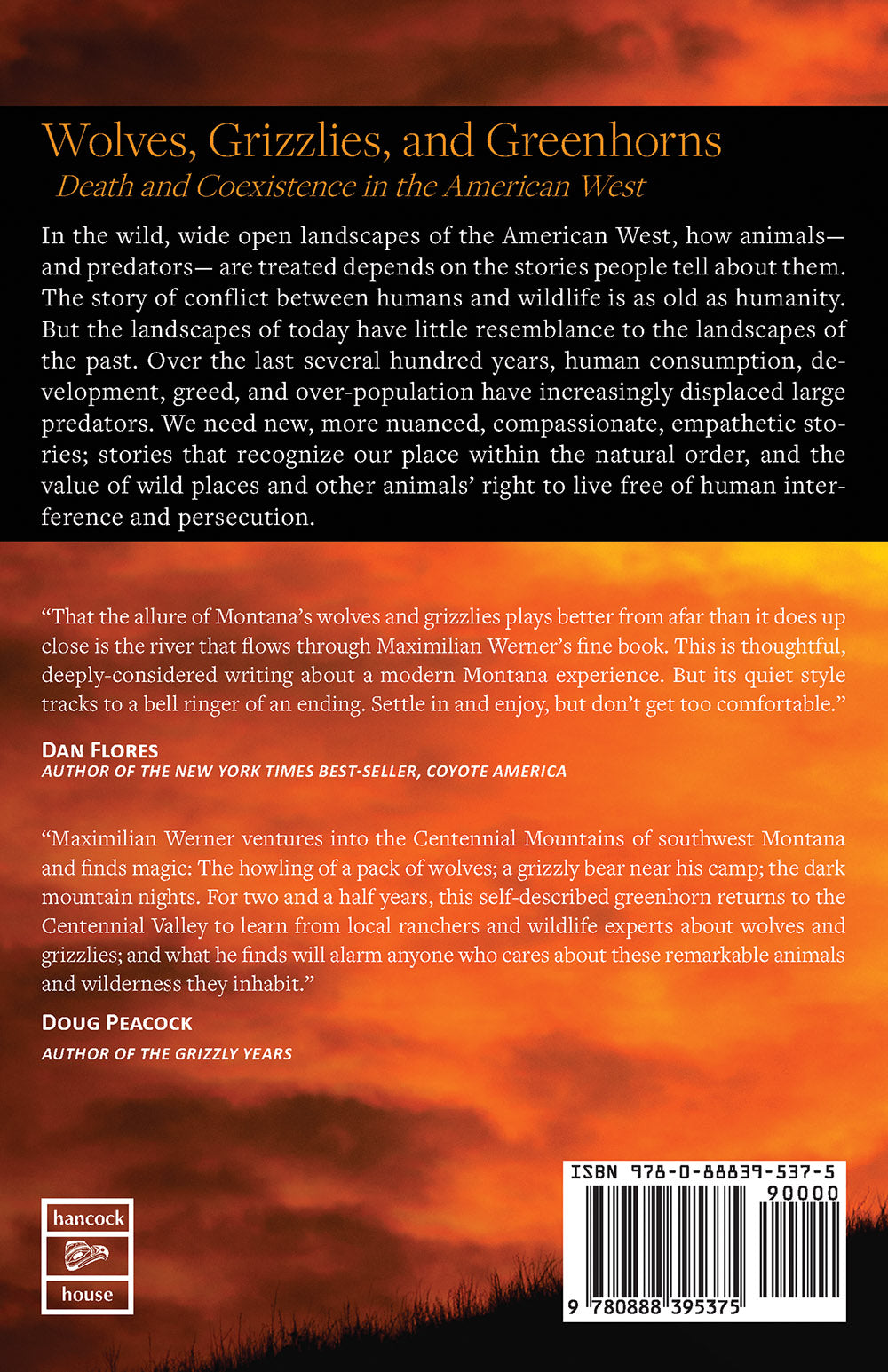




Wolves, Grizzlies and Greenhorns: Death and Coexistence in the American West
NEWLY RELEASED!
(note: the author will be donating 15% of royalties received to the Centennial Valley Range Rider Program)
Details
By: Maximilian Werner
ISBN: 978-0-88839-537-5 [Trade Paperback]
ISBN: 978-0-88839-578-8 [eBook] Kindle Version
Binding: Trade Paper
Size: 5.5" X 8.5"
Pages: 352
Maps: 2
Illustrations/Photos: 7
Publication Date: 01 May 2021
Description
In Wolves, Grizzlies, and Greenhorns -- Death and Coexistence in the American West, Werner recounts the two-and-a-half years he spent tracking down and looking after a wolf pack that was rumored to have settled in the Centennial Valley of southwest Montana. Along the way he encounters and reflects on the lives of other animals, including deer, elk, fox, coyote, skunks, and grizzly bears. But he also encounters other humans too—ranchers, hunters, land and wildlife managers, cowboys—who offer their own, often conflicting perspectives about the natural world, other animals, and how both ought to be treated.
In the wild, wide-open landscapes of the American West, how animals are treated depends on the stories people tell about them, as well as on their ability to steer clear of humans and their livestock—no easy task for animals that are running out of places to go!
The story of conflict between humans and wildlife is as old as humanity. But the landscapes of today bear little resemblance to the landscapes of the past. Over the last several hundred years, human consumption, development, greed, and over-population have increasingly displaced large predators. We need new, more nuanced, compassionate, empathetic stories, Werner argues; stories that recognize our place within the natural order, and the value of wild places and other animals’ right to live free of human interference. Wolves, Grizzlies, and Greenhorns – Death and Coexistence in the American West is one of those stories.
Author Biography
Maximilian Werner is the award-winning author of seven books,  including the essay collections Black River Dreams and The Bone Pile: Essays on Nature and Culture; the memoir Gravity Hill; the nonfiction book Evolved: Chronicles of the Pleistocene Mind; the novel Crooked Creek, and a book of poems titled Cold Blessings. He is an Associate Professor/lecturer in the Department of Writing and Rhetoric Studies at the University of Utah, where he teaches Intermediate Writing, Investigative Environmental Writing and Writing about War.
including the essay collections Black River Dreams and The Bone Pile: Essays on Nature and Culture; the memoir Gravity Hill; the nonfiction book Evolved: Chronicles of the Pleistocene Mind; the novel Crooked Creek, and a book of poems titled Cold Blessings. He is an Associate Professor/lecturer in the Department of Writing and Rhetoric Studies at the University of Utah, where he teaches Intermediate Writing, Investigative Environmental Writing and Writing about War.
Book Reviews
“That the allure of Montana’s wolves and grizzlies plays better from afar than it does up close is the river that flows through Maximilian Werner’s fine book. This is thoughtful,
deeply-considered writing about a modern Montana experience. But its quiet style tracks to a bell ringer of an ending. Settle in and enjoy, but don’t get too comfortable.”
--Dan Flores, author of New York Times Best Seller, Coyote America
“Maximilian Werner ventures into the Centennial Mountains of southwest Montana and finds magic: The howling of a pack of wolves; a grizzly bear near his camp; the dark
mountain nights. For two and a half years, this self-described greenhorn returns to the Centennial Valley to learn from local ranchers and wildlife experts about wolves and grizzlies; and what he finds will alarm anyone who cares about these remarkable animals and wilderness they inhabit.”
--Doug Peacock, author of The Grizzly Years
“In his new book Maximilian Werner invites us to join him in a quest that involves adventure, mystery, and an intimate look into his psyche while challenging readers to reflect on their own. For several years Werner searches for solid evidence of a wolf pack in the Centennial Mountains of southwest Montana. From the beginning, he believes the pack, if it exists, is doomed. The story, it seems, will be a dramatic tragedy.During many brief forays from his home in Salt Lake City, Werner (a University of Utah professor)—sometimes accompanied by his dog Rufus, a family member, or a former student—traces signs of the rumored pack. He talks with wildlife officials from several agencies along with the occasional hunter or rancher, immersing himself in wilderness experiences that range from pastoral to austere. Continually worried about a grizzly encounter, he goes armed with two cans of bear spray, one in a holster, another in his hand. Werner claims no objectivity as he jumps into the ongoing controversy over wolves. He is unabashed about his loyalties: the problem lies with people, particularly those in agriculture and livestock raising, in secretive government agencies, and with hunters. What’s known as the North American Model of Wildlife Conservation, spawned by the likes of Theodore Roosevelt, George Bird Grinnell, and Aldo Leopold, gets no mention or credit. Instead, “One need only look at the last 160 years of wildlife management in the US to see histories written with bullets, traps, snares, poison, and blood”(36). Conflict between humans and predators was eons old when the future King David honed his slingshot on lions and wolves threatening his flocks. In 1994, killing time in a laundromat in Madrid, I mustered enough Spanish to read in a slick-papered hunting magazine how wolves were proliferating under protections favored by urbanites and the EU. Translated, with changes to a few proper nouns, the article could have been written in Montana. To a rancher/reviewer and erstwhile academic who lives within howling distance of the Yellowstone packs, would Werner’s world be still another treatise advocating the proliferation of wolves in our Montana mountains? Would it do more than provoke an inward chorus of “But . . .” or “You seem to be forgetting . . . ?” Thankfully, yes. Werner is a fine writer. The outdoorsman can’t fail to respond to passages such as this: “Half the storm had fallen as rain. The air was heavy with the sweet smell of it and fog steeped with the smell of wet grass and frost had settled on the valley floor, while high above us the Centennials were sashed with clouds and snow” (187).
We’re invited into the author’s personal world, including Werner’s interaction with others (particularly his father). They and the wolves he seeks become part of that intimacy. Long before he sees them, Werner calls the pack “my pack,” the wolves “my wolves.” By opening his personal space Werner creates empathy, if not complete agreement with his positions on wildlife management. Personal writing is universal writing; shared experiences in the outdoors mesh with those of background. I studied at Werner’s university a generation earlier and was led as I read to recall a much-loved Utah professor and his favorite question, one pertinent to this book. Shoulder to shoulder with Don D. Walker, sharp knives in hand while removing the hide from a mule deer I’d shot during one of Walker’s famous “rendezvous” for peers and students who honored Chaucer’s monk, distance to this august yet friendly professor dissolved, but only momentarily. Back in class he issued the familiar challenge: What assumptions underlie the statement (or assertion or question)? Assumptions abound regarding management of large predators. Werner sees the Centennial pack as individuals. Montana Fish, Wildlife and Parks, whose journal arrived while I read Werner’s book, listed the original population target for wolves in Montana at one hundred, then one hundred fifty, far exceeded by the current count, around eleven hundred. The species from the agency’s point of view is in fine shape. And, in the same time frame, a physician friend sent photos of the mangled hind leg of a colt owned by an ER nurse with whom he works. It’s rumored that a single wolf was killed by a helicopter gunner in the days following. And so it goes. Werner’s book can be read as a pro-wolf polemic but is better approached as a fine work of nature and an exposé of the writer’s soul (and perhaps our own). There’s a Biblical quality about the last sentence, a voice crying out in the wilderness wishing for an answer in the form of a wolf’s howl, but also for answers to those mysteries and longings we all share.”
--Dan Aadland, PhD, Western American Literature Vol 57, No.2, 2022.
